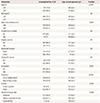1. Research on. Report of a WHO Scientific Group. World Health Organ Tech Rep Ser. 1996; 866:1–107.
2. Bromberger JT, Matthews KA, Kuller LH, Wing RR, Meilahn EN, Plantinga P. Prospective study of the determinants of age at menopause. Am J Epidemiol. 1997; 145:124–133.
3. Beser E, Aydemir V, Bozkaya H. Body mass index and age at natural menopause. Gynecol Obstet Invest. 1994; 37:40–42.
4. Luoto R, Kaprio J, Uutela A. Age at natural menopause and sociodemographic status in Finland. Am J Epidemiol. 1994; 139:64–76.
5. Cramer DW, Harlow BL, Xu H, Fraer C, Barbieri R. Cross-sectional and case-controlled analyses of the association between smoking and early menopause. Maturitas. 1995; 22:79–87.
6. Worley RJ. Age, estrogen, and bone density. Clin Obstet Gynecol. 1981; 24:203–218.
7. Jacobsen BK, Heuch I, Kvale G. Age at natural menopause and stroke mortality: cohort study with 3561 stroke deaths during 37-year follow-up. Stroke. 2004; 35:1548–1551.
8. Sternfeld B, Bhat AK, Wang H, Sharp T, Quesenberry CP Jr. Menopause, physical activity, and body composition/fat distribution in midlife women. Med Sci Sports Exerc. 2005; 37:1195–1202.
9. Kawas C, Resnick S, Morrison A, Brookmeyer R, Corrada M, Zonderman A, et al. A prospective study of estrogen replacement therapy and the risk of developing Alzheimer’s disease: the Baltimore Longitudinal Study of Aging. Neurology. 1997; 48:1517–1521.
10. Murabito JM, Yang Q, Fox C, Wilson PW, Cupples LA. Heritability of age at natural menopause in the Framingham Heart Study. J Clin Endocrinol Metab. 2005; 90:3427–3430.
11. van Noord PA, Dubas JS, Dorland M, Boersma H, te Velde E. Age at natural menopause in a population-based screening cohort: the role of menarche, fecundity, and lifestyle factors. Fertil Steril. 1997; 68:95–102.
12. Hardy R, Kuh D, Wadsworth M. Smoking, body mass index, socioeconomic status and the menopausal transition in a British national cohort. Int J Epidemiol. 2000; 29:845–851.
13. Parazzini F. Progetto Menopausa Italia Study Group. Determinants of age at menopause in women attending menopause clinics in Italy. Maturitas. 2007; 56:280–287.
14. Harlow BL, Signorello LB. Factors associated with early menopause. Maturitas. 2000; 35:3–9.
15. Park HA. The Korea national health and nutrition examination survey as a primary data source. Korean J Fam Med. 2013; 34:79.
16. Dorjgochoo T, Kallianpur A, Gao YT, Cai H, Yang G, Li H, et al. Dietary and lifestyle predictors of age at natural menopause and reproductive span in the Shanghai Women's Health Study. Menopause. 2008; 15:924–933.
17. Abdollahi AA, Qorbani M, Asayesh H, Rezapour A, Noroozi M, Mansourian M, et al. The menopausal age and associated factors in Gorgan, Iran. Med J Islam Repub Iran. 2013; 27:50–56.
18. Ayatollahi SM, Ghaem H, Ayatollahi SA. Menstrual-reproductive factors and age at natural menopause in Iran. Int J Gynaecol Obstet. 2003; 80:311–313.
19. McKinlay SM, Bifano NL, McKinlay JB. Smoking and age at menopause in women. Ann Intern Med. 1985; 103:350–356.
20. Cooper GS, Baird DD, Darden FR. Measures of menopausal status in relation to demographic, reproductive, and behavioral characteristics in a population-based study of women aged 35-49 years. Am J Epidemiol. 2001; 153:1159–1165.
21. Kaczmarek M. The timing of natural menopause in Poland and associated factors. Maturitas. 2007; 57:139–153.
22. Torgerson DJ, Avenell A, Russell IT, Reid DM. Factors associated with onset of menopause in women aged 45-49. Maturitas. 1994; 19:83–92.
23. Fallahzadeh H. Age at natural menopause in Yazd, Islamic Republic of Iran. Menopause. 2007; 14:900–904.
24. Kinney A, Kline J, Kelly A, Reuss ML, Levin B. Smoking, alcohol and caffeine in relation to ovarian age during the reproductive years. Hum Reprod. 2007; 22:1175–1185.
25. Brett KM, Cooper GS. Associations with menopause and menopausal transition in a nationally representative US sample. Maturitas. 2003; 45:89–97.
26. Sun L, Tan L, Yang F, Luo Y, Li X, Deng HW, et al. Meta-analysis suggests that smoking is associated with an increased risk of early natural menopause. Menopause. 2012; 19:126–132.







 PDF
PDF ePub
ePub Citation
Citation Print
Print



 XML Download
XML Download